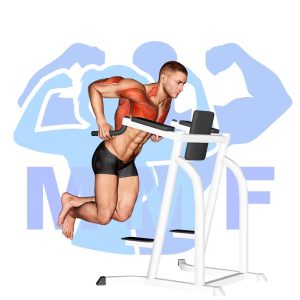Are you struggling to target your rear deltoids during your workouts? Perhaps you’ve tried multiple exercises but haven’t seen the results you’re looking for. Don’t worry, you’re not alone. Many people struggle to activate and strengthen their rear delts, leading to imbalances in their shoulder muscles. One common cause of this is neglecting to include exercises that specifically target this muscle group. But fear not, the solution to your problem can be found in the band rear deltoid row exercise. In this post, we’ll dive into the benefits of this exercise and how to properly execute it for maximum results.
Band Rear Deltoid Row Summary
- Primary Muscles: Deltoid – Posterior
- Secondary Muscles: Brachialis, Brachioradialis, Infraspinatus, Latissimus Dorsi, Rhomboids, Teres Minor, Trapezius – Lower, and Trapezius – Middle
- Equipment: Resistance Band
- Mechanics Type: Compound
- Force: Pull
- Utility: Basic

Band Rear Deltoid Row Instructions
- Start by setting a setting up the bands on a high anchor point..
- Next, grab the handles with both hands and your arm stretch out in front of your face.
- Then pull back with your elbows at the same height as your shoulders, squeezing your upper back.
- To finish allow the band to pull your arms back straight.
- Repeat your band rows for a complete set.
Video Tutorial
Band Rear Deltoid Row Muscles
Target (Agonist)
Synergists
- Brachialis
- Brachioradialis
- Infraspinatus
- Latissimus Dorsi
- Rhomboids
- Teres Minor
- Trapezius – Lower
- Trapezius – Middle
- Wrist Flexors
Dynamic Stabilizers
Stabilizers
Antagonist Stabilizers

Benefits of Band Rear Deltoid Row
The Band Rear Deltoid Row is an excellent exercise to strengthen the posterior deltoid muscle. This exercise activates the posterior deltoid, making it an effective strength training exercise for the shoulder area. It also helps to improve posture and stability in the shoulder region, as well as enhance shoulder joint mobility. Additionally, this exercise can also be used to improve overall balance, flexibility, and stability in the upper body. Finally, due to its effectiveness in targeting the posterior deltoid, it can be used to help build strength and size in this muscle.
Tips for Performing Band Rear Deltoid Row
The rear deltoid row is an essential part of any fitness program. It helps strengthen your back, shoulders, and core muscles, while also increasing your range of motion and flexibility. With regular practice, you can get the most out of this exercise and reap the benefits of a strong and healthy body. Here are some tips on how to get the most out of your rear deltoid rows.
- Use the full range of motion. Ensure the band is tight and providing resistance for the entire exercise.
- To increase the resistance with out getting a bigger band, step back farther from the anchor.
- Lower the resistance, similar to increasing resistance, to lower resistance get closer to the anchor. Remember to keep the band tight the entire time.
Benefits and Tips Video
Frequent Mistakes To Avoid
When it comes to working out, it’s important to be mindful of your form and technique to avoid any injuries. With the band rear deltoid row, there are some common mistakes that people make which can lead to poor posture and incorrect form. In order to get the most out of this exercise and stay safe, it’s important to learn about and avoid these common mistakes.
- Try Not To Skip Out On A Warmup. Warming up your Muscle tissue is the Fastest way to prevent injury.
- Stop Yourself From Using Too Little or Too Much Tension. Not enough, and you will not be sufficiently employing your main muscle, more than the right amount, and you will likely need to cheat. Be sure you can perform between 8-12 reps with good technique.
- You Must Not Skip Recovery Days. Over-training can certainly help make you weakened rather than stronger.
Find More Resistance Band Exercises Here
Variations and Complementary Exercises
If you’re looking to mix up your shoulder workout routine and target the same muscles as the Band Rear Deltoid Row, here are a few variations, complementary, or alternative exercises that you can add to your routine.
Barbell Incline Row

The Barbell Incline Row is a great complement to the Band Rear Deltoid Row, working many of the same muscles while also incorporating additional muscles. This exercise requires the user to lean forward onto an inclined bench, holding the barbell with an overhand grip and the elbows close to the body. The user then pulls the weight up towards the chest, engaging the back and shoulder muscles while also engaging the core muscles to stabilize. The Barbell Incline Row is a great alternative to the Band Rear Deltoid Row as it adds an element of resistance that can help to further challenge and strengthen the muscles used in the exercise.
Barbell Reverse Grip Bent Over Row

The Barbell Reverse Grip Bent Over Row is a great exercise to complement or use as an alternative to the Band Rear Deltoid Row. This exercise targets the back, shoulders, and biceps muscles and is done by bending over with a barbell in your hands, holding it with an overhand grip, and then pulling the bar up towards your chest. The key to this exercise is to keep your back straight and tight, and your elbows close to your body. This exercise helps to strengthen the muscles of the upper back, while also targeting the rear deltoids and biceps.
Cable Rope Face Pull

Cable Rope Face Pulls are a great complementary or alternative exercise for the Band Rear Deltoid Row. This exercise focuses on working the rear deltoids, as well as the trapezius, rhomboids, and biceps. The cable rope face pull is a compound exercise that works multiple muscles simultaneously, and it can be done with a variety of hand positions to target different muscles. The cable rope face pull requires the user to pull the rope towards their face while keeping their arms outstretched, which helps to engage the rear deltoids and create tension in the back. Cable rope face pulls can also be done with heavier weight than band rear deltoid rows, allowing for a greater range of motion and more intense muscle contractions.
Check Out These Top Resistance Band Exercises
Dumbbell Bent Over Row

The Dumbbell Bent Over Row is a great complementary or alternative exercise to the Band Rear Deltoid Row. It works the same muscles – the rear delts, rhomboids, and lats – but can be done with heavier weights and allows for more range of motion. It is a compound exercise that also engages the core, biceps, and forearms for greater stability and strength. Additionally, the bent over position allows for more activation of the lower back muscles, helping to increase overall strength and muscle development.
Lever One Arm Lateral High Row (Machine)

The Lever One Arm Lateral High Row (Machine) is a great alternative or complementary exercise to the Band Rear Deltoid Row. This machine allows for greater control over the range of motion and intensity of the exercise, as well as providing more stability for the user. It targets the same muscles as the Band Rear Deltoid Row but allows for an increased level of control and precision over the movement. The Lever One Arm Lateral High Row (Machine) can be used to isolate specific muscles and increase overall shoulder strength, allowing for greater gains in shoulder size and strength when combined with other exercises.
Seated V Bar Cable Row

The Seated V Bar Cable Row is a great alternative or complementary exercise for the Band Rear Deltoid Row. This exercise works the back muscles, specifically the lats, rhomboids and traps, while also engaging the biceps. The Seated V Bar Cable Row can be performed seated with a cable machine, which allows you to adjust the weight and difficulty of the exercise. Additionally, you can target different muscle groups by adjusting your grip on the bar, such as a close or wide grip. This exercise is an effective way to build strength in the back and shoulders, and can be easily adjusted to accommodate any level of fitness.
Find More Back Exercises Here
Opposing Complementary Exercises
The Band Rear Deltoid Row is an effective exercise for strengthening the rear deltoid muscles. To maximize the benefit of this exercise, it should be complemented with exercises that work the opposing muscle groups. The following exercises will help to balance out the strength in the shoulders and improve posture:
Chest Dip

The chest dip is a great exercise to compliment the band rear deltoid row, as it works the opposing muscle group. This exercise targets the chest and triceps while providing an effective stretch to both of these muscles. It also helps to increase upper body strength and stability. The chest dip should be performed slowly and controlled, and is best performed with a partner spotting you to ensure safety and correct form. By performing this exercise in combination with the band rear deltoid row, you can effectively target both the front and back of the shoulder for a balanced upper body workout.
Weighted Tricep Dips

Weighted Tricep Dips are a great complement to the Band Rear Deltoid Row as it works the opposing muscle group. This exercise involves holding onto two parallel bars while keeping your body straight. You then lower your body, bending at the elbows, until your arms form a 90 degree angle. You then press your body back up to the starting position. This exercise is great for targeting the triceps and strengthening the muscles in the upper arms. By doing Weighted Tricep Dips in combination with Band Rear Deltoid Rows, you can develop both muscle groups in the upper arms and help improve overall arm strength.
Smith Machine Bench Press

The Smith Machine Bench Press is a great complement to the Band Rear Deltoid Row, as it works the opposing muscle group. The Smith Machine Bench Press works the chest and triceps muscles, while the Band Rear Deltoid Row works the back and shoulders. Together, these exercises create a balanced workout, allowing for maximum development of both the upper body and core muscles. With this combination, you can achieve a more efficient workout that will help you reach your fitness goals faster.
Stronger Shoulders Ahead
Stronger shoulders not only look great, but they play an important role in everyday activities and sports performance. Developing your rear deltoids, the muscles at the back of your shoulders, is key to achieving a well-rounded shoulder definition. By incorporating exercises that target your rear delts, you can improve your posture, reduce your risk of injury, and enhance your upper-body strength. Let’s dive in to learn more about how to make your rear delts stronger with the use of resistance bands.
References: Wikipedia | ExRx.net | PubMed.gov | Comprehensive List of Back Resistance Band Exercises




